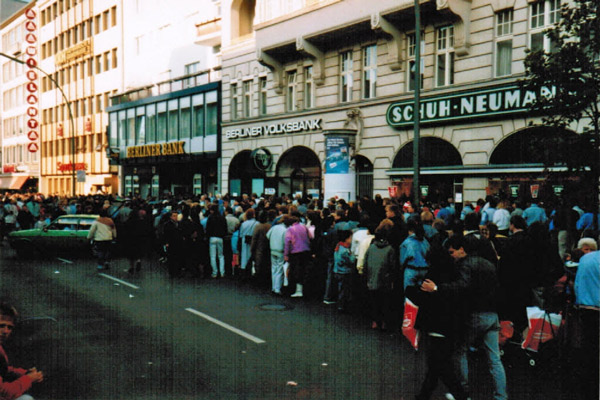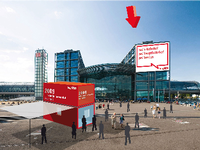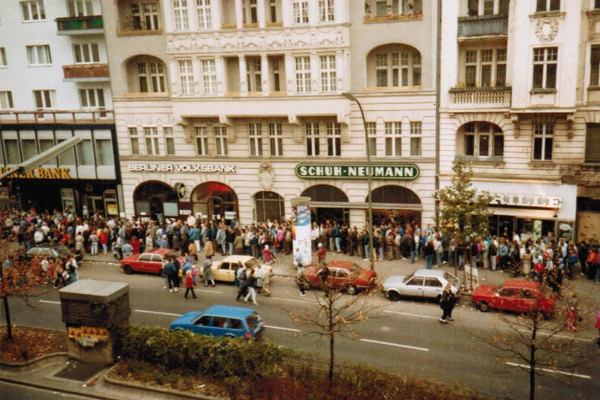Begrüßungsgeld
The money was a welcome support in the Federal Republic of Germany entering the country each citizen of the German Democratic Republic and the former People's Republic of Poland, as far as a German descent could be detected, was granted funds from the federal budget. It was introduced in 1970 in the amount of 30 Deutsche Mark and could be availed twice a year. 1988 was increased to $ 100, but limited to a single annual use. Special political and economic importance was the welcome money as a result of the opening of the inner-German border on November 9, 1989.
Political occasion
After the erection of the Berlin Wall on August 13, 1961, the border of the GDR was finally closed to the Federal Republic of Germany and the flow of refugees to the West, it was decided curbed. Visitors from the GDR could only come from a special permission to leave to the West, which was, however, very rarely granted. Due to the under the chancellorship of Willy Brandt in 1969 concluded treaties with the East also travel facilities for inhabitants of the GDR, which allowed mainly pensioners a visit to the Federal Republic revealed. The emigrants but was only allowed to take 70 marks the GDR. In order to improve the conditions of entry of visitors from the GDR, the Federal Government launched from 1970, the payment of a welcome money in the amount of 30 DM, which was every visitor made upon presentation of his identification papers. Until 1984, each year 40,000 to 60,000 visitors came to enjoy the welcome money, as of 1985, their number rose sharply due to the agreed extension of visiting privileges, reaching in 1987 1.3 million on August 26, 1987 the federal government decided to increase the splash money on DM 100, However, at the same time be limited to a one-time payment per person per year. The GDR had reduced the allowable exchange for their traveling to the West citizens from 70 to 15 marks from 1 July ( which could be converted into 1:1 DM), which should be offset by the increase in the welcome money. 1988 a total of 260 million DM were paid as a welcome money, even for 1989 saw the budget from this sum.
Method
The welcome money was on presentation of their identity card or passport of the Federal Republic to the city and municipal administrations are requested and was paid there. The payout was noted in the papers to avoid undue repeated use.
After the Berlin Wall
Arrangements and implementation
The payment of welcome money initially focused only on the lower visitor numbers, arising by the GDR for its citizens largely restricted freedom to travel, but had to adapt since 1985 greatly increased visitor numbers.
As for the wall, opening all GDR citizens could travel to the Federal Republic and West Berlin, this led to significant logistical problems. Immediately after the Wall came down it came briefly to chaotic scenes, so on the first Monday after the wall in front of the bank in the Bath Street in Berlin- fresh spring, at the Moritz Platz in Berlin -Kreuzberg or at the Zoological Garden in Berlin- Tiergarten, as up to 10,000 GDR citizens from the payment offices stood in line at the same time, the traffic totally collapsed and police, fire and rescue services auffuhren to bring the situation under control.
Even on the night of November 10 ordered the Governing Mayor of Berlin, Walter Momper to the payment of money by greeting and savings banks, which kept their offices open even during the night. The payment way by banks and savings banks was taken in the following days throughout the Federal Republic. The conditions for payment have been simplified and limited to the mere presentation of an identity card or passport, repeated drawdowns were little more controllable.
Until 11 November, more than three million inhabitants of the GDR had already visited the West. The GDR presented between 9 and 13 November from 4.5 million visas to visit West Berlin and the Federal Republic of Germany. Up to November 20, eleven million visitors came from the GDR.
Some states, such as Bavaria, which granted an increase of 40 DM per person and municipalities, such as Munich, still paid surcharges to welcome money, what the travel behavior of GDR citizens probably influenced.
The payment of the money greeting was posted on Friday, December 29, 1989 and replaced by the agreements between the Federal Republic and the Council of Ministers of the GDR foreign exchange funds, einzahlten in both countries. Each GDR citizens could from him 100 GDR marks in the ratio 1:1 and another 100 DDR - Mark exchange in D- Mark in the ratio 1:5.
Total amount of payments
In just the first three weeks after the fall of the wall paid the Federal Republic of welcome money from 18 million visitors. In an interview on December 3, 1989 in Brussels, Chancellor Helmut Kohl amounted to U.S. President George Bush, the total amount paid since the opening of the borders of greeting funds to DM 1.8 billion Strangely, based most other published figures on mere estimates. In connection with the effect on 1 January 1990 force Currency Fund, the federal government could be explained, in this fund flowed also 1.4 billion DM, with whom you otherwise would have to reckon as payments to welcome money in 1990, Federal Minister Rudolf Seiter estimated the expected expenses for the welcome money in a conversation with the Council of State, Egon Krenz on 20 November 1989 with 1.6 billion DM This is less than carbon has given only for the first three weeks since the opening of the borders. In view of the unbroken also in December 1989, visitor flow is assumed that this month in about the same amount again is incurred as in November. It is therefore assumed that a total of three to four billion DM, which was paid in November and December 1989 as a welcome money.
Economic importance for the citizens of the GDR
By 1987 had to be paid for an average of 4 1 DM Mark of the GDR, 1988, the exchange ratio rose to the free market already 1:10 and reached finally to the frontiers 1:20. This became the welcome money beyond the immediate purpose of an invitation to buy consumer goods in the West, also a financial impact, the Chancellor Kohl in his interview on December 3, 1989, President Bush was indicating follows:
" An urgent question is the replacement of welcome money. The payments to the GDR residents who come into the Federal Republic to visit, now amount to about DM 1.8 billion already so it can not go on. The welcome money has been introduced at a time when only retirees were allowed to travel to West Germany. If now, for example, a couple traveling with three children in the West, it gains 500 DM welcome money. If goods purchased for $ 20 with us and DM 30 converts at the rate of 1:20 again in Mark of the GDR, it still brings from this trip almost six average salaries with back ... On 31 December 1989, the payment of the allowance shall be suspended welcome. "
This shows that the welcome money for visitors from the GDR of far greater economic importance was when originally adopted from the perspective of it as a kind of a gift granted to the Federal Republic. Due to the entry into force only half a year later, on 1 July 1990 monetary, economic and social union between the Federal Republic of Germany and the GDR appropriate DDR -Mark credit could then mostly in a 1:1 ratio, or beyond in relation 1:2 are exchanged. Surveys from the early days of the opening of the border had, however, been shown that the welcome money was implemented without delay in foods such as coffee, chocolate and tropical fruits.
Political significance
The political significance and impact of the payments of the welcome money after the opening of the borders are disputed. While some go so far as to complain that GDR citizens had even sold their order for money, others point out that and in this day and age with changes and transitions in state and society, the issues of economic well-being, income, savings of consumption, trade and the economy far more importance gain than those of sovereignty and political dogma.
The turn of the turn: Converted objectives
With the opening of the borders to the West were changing the political objectives of the majority of the population of the GDR. The number of participants in the Monday demonstrations, which had about reached on November 6 in Leipzig with almost 500,000 from its peak level went up to the end of December to around 150,000. Originally aiming at an improvement of the state and Socialism demands now turned to align with the existing conditions of life in the West, the reputation We are the people became more and more by the West Germany also with inclusive reputation We are replacing a people. The desire for economic improvement has become a major driving force on the path to reunification. It was what some called the turn of the turn. Many who had visited the West, felt themselves to be deceived by their own government. However, in December 1989, there was no majority in East Germany for reunification, only 27 percent were in favor, 89 percent, however, called for reform of the GDR. According to another on 17 December 1989 survey conducted to 73 percent spoke in favor of a sovereign GDR and 71 percent supported socialism, however, 39 percent wanted already a Western economic system, but the mood changed noticeably. On 6 February 1990, Chancellor Kohl offered the replacement of East German marks to the DM and in the parliamentary elections of 18 March 1990, a reunion dissenting parties were only less than 25 percent of the vote, the State invited to roundtable parties and movements which must be regarded as carriers of early Monday demonstrations, now united with the Alliance 90, achieved only 2.9 percent of the vote. The opening to the Federal Republic and the experience acquired in their visits own experience did not miss its mark.
Consumerism and GDR politics
The welcome money had been invited to a test of the consumption standards of the West German economy and a large number of GDR residents accepted the invitation. The view of the West German consumer landscape played in the political reality of the GDR always a special role. Walter Ulbricht announced in the fifties, the short-term overtaking the West German consumption standards and when this failed to materialize, in 1959 announced the seven-year plan of peace, prosperity and happiness. In the disempowerment Ulbricht by Erich Honecker, the question of neglect of the consumer interests of the population played an important role. Honecker unit of social and economic policies aimed at an amplified by an increase in social welfare and prosperity, economic growth, communism must foster a society of consumption and a generous welfare state. During his era, consumer spending increased sharply and were almost twice as high as the investment costs, subsidies to consumer spending increased six-fold from 1971 until 1988. Fact, however, the distance to the west grew and grew through the neglect of investment in favor of consumption, the debt substantially, which in turn limited the service consumption. The Stasi therefore resulted in the grounds of the mass demonstrations that from the beginning of the discontent of the protesters with the supply situation on. So that increasingly gained importance after the opening of the western frontier and allowing to test the West German consumption standard, the assessment of their own perceived as awkward supply situation in the political decisions of the population, therefore, appears to be mandatory. The DM has become a symbol for the strongly desired better standard of living, as reflected in banners like " Either the Mark comes to us and we remain or, if not, we come to Mark " or a demonstration on January 21, 1990 at the border crossing Duderstadt -Worbis where about 20,000 residents of the GDR, equipped with suitcases for the introduction of the DM demonstrated uttered a symbolic power that had obtained by the welcome money for a short time reality.










